| Columns Retired Columns & Blogs |
"It's Time" ........... Imagine Dragons :-) .............
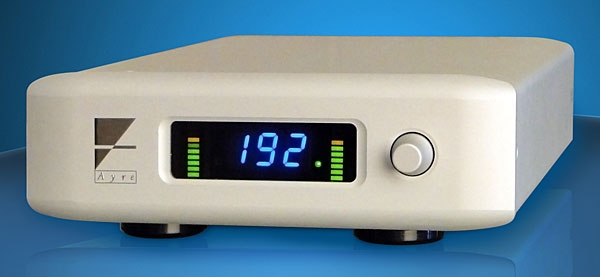
But elegant it is, I feel. MQA Ltd.'s Bob Stuart has described the goal of MQA as being to reduce to "plumbing" everything between the original analog signal fed to the analog/digital (A/D) converter and the analog signal output by the digital/analog (D/A) converter, other than routing the signal from the original event to the end-user's system. In other words, the A/D conversion of the output of the microphone preamps (in a purist recording) or the mixing console (in a conventional recording), the transmission, storage, and subsequent D/A conversion will be transparent, except for an ultrasonic rolloff equivalent to a signal path of a few feet in air.
Of course, there will still be the limitations of the sample rate and bit depth chosen for the conversion of analog to digital, and in this article I examine what happens when that conversion takes place and the implications for MQA.
D/A Conversion
An A/D converter works by sampling and encoding the original analog signal and producing a datastream consisting of a regular string of numbers. Each number describes the amplitude of the signal at a time interval 1/S second after the previous one (S is the sampling frequency). To reconstruct the signal, this stream of data is fed to a D/A converter that outputs a pulse every 1/S second, the height of the pulses approximately mapping out the analog signal's original shape. (Practical DACs use a sample-and-hold circuit to turn each pulse into a DC voltage step, but that is immaterial to the point.)
As outlined by Claude Shannon in his classic 1949 paper (footnote 1), for theoretically perfect waveform preservation, the bandwidth of the signal to be sampled needs to be restricted to half the A/D converter's sample rate by what is called an antialiasing filter. However, the spectrum of the sampled data doesn't extend to half the sample rate, as you might expect (fig.1); it extends to an infinitely high frequency, the spectrum of the band-limited audio signal mirrored to either side of the sample rate and every one of its harmonics (fig.2). When the digital data are used to re-create the analog signal, these ultrasonic "images" need to be eliminated. This is performed by the D/A converter's reconstruction filter, so called because, as well as removing the ultrasonic images, it reconstructs the original band-limited analog signal not just at the sampling points in time but between those points.
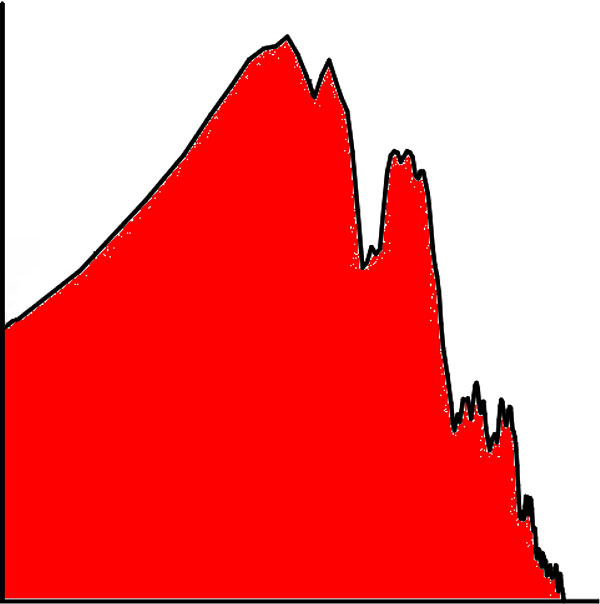

In one of the first articles I wrote for Stereophile, in 1986, I examined how the impulse response of the D/A converter's reconstruction filter is fundamental to this process. In engineerspeak, the digital filter convolves the digital audio data with the filter's impulse response. A digital filter comprises a series array of multiplication units or "taps," each separated in time by a single sample delay, and with a summing unit fed the outputs of every multiplier to create the filtered output data fed to the DAC. As the first data word is fed to the first multiplier, it's multiplied by the coefficient stored for that multiplier, and is then fed to the second multiplier as the next data word is fed to the first multiplier—and so on until the data exit the final multiplier, the sum of the multiplier outputs at each sampling instant exactly reproducing the bandwidth-limited, but now filtered waveform.
If you plot this series of filter coefficients against time, you get the familiar filter impulse response that I publish in our reviews of digital processors (fig.3). The kind of filter shown in this graph, which offers a very steep rolloff above the passband, is almost ubiquitous in digital audio products. The actual shape of this filter's time-domain response is called a (sin x)/x or sinc function curve. The "ringing" occurs at exactly half the sample frequency, called the Nyquist frequency, extends in time (in theory) from minus infinity to plus infinity, and decays very slowly on either side of the central peak. This filter is linear-phase in nature, meaning that there is no phase distortion; however, the more you constrain the data in the frequency domain, the less you can do so in the time domain, and a sinc-function filter smears the transient's energy in an extreme manner.
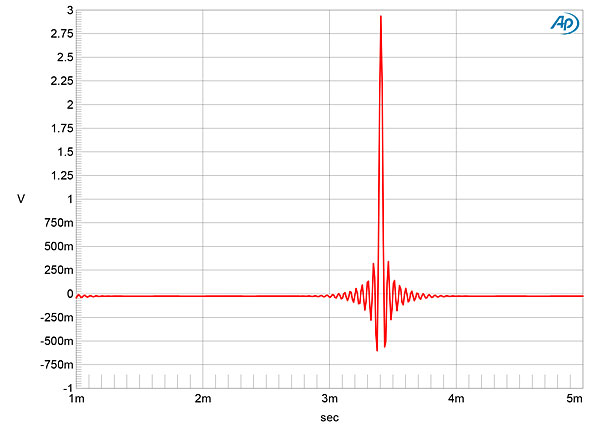
In natural sound, echoes always occur after a sound—never before. This pre-echo is therefore unnatural; and while a continuous waveform will be reconstructed correctly, it is possible that the pre-echo might well be heard as a degradation with a discontinuous waveform, such as musical transients (see later).
A/D Conversion
But what about the other end of the process, where the analog signal is converted to a digital datastream? All modern A/D converters are sigma-delta types in which a converter with a limited bit depth operates at an extremely high sample rate. A digital decimation filter is then used to create the conventional multi-bit PCM datastream sampled at the familiar rates: 44.1kHz and its multiples, 48kHz and its multiples. This filter will overlay its own impulse response on that datastream, and this is when time smear—what Bob Stuart calls temporal blur—raises its head.
To examine the response to an impulse of a D/A converter's reconstruction filters, I use a test signal I created that comprises 16-bit/44.1kHz "digital black" or silence into which I inserted a single sample at full scale to create the shortest possible pulse at this sample rate. While this isn't a signal a DAC will encounter with music data, a DAC's response to this single sample "maps" the coefficients of its reconstruction filter. To characterize the antialiasing filter of an A/D converter, therefore, I first thought about using a signal generator to create a similarly short analog pulse—back in the late 1980s, I built a monostable multivibrator circuit with adjustable pulse width for this purpose. But while that analog pulse would indeed reveal the antialiasing filter's impulse response, A/D converters would never be confronted with such a signal in real life. For the tests I'm about to describe, therefore, I felt it more appropriate to use an analog test signal that approximated music.
Using the pencil tool supplied with the BIAS Peak program (no longer available), I drew several arbitrary impulse-response waveforms sampled at 384kHz. These ranged from a simple square pulse to various shaped pulses of various lengths, as well as an asymmetrical triangular impulse similar to the MQA test-signal waveform shown on p.139 of our January 2018 issue. My goal was to present the ADC with a signal that gently rolled off above the audioband and had no significant energy above 60kHz. (Work by Bob Stuart and others has shown that 60kHz is the approximate upper limit of music information.) Fig.4 shows the waveform of the impulse I created—it peaks at –3dB, so there's no danger of converter overload—and fig.5 shows its spectrum. The vertical green line to the right of this graph is placed at 60kHz—you can see that the signal's content above 60kHz is down at least 20dB from the audioband level. The spectrum is white rather than pink, but this doesn't affect the measurements.


To create the analog equivalent of this digital signal, I used the Pure Music 3.0 app on my MacBook Pro to send the impulse data to a Mytek HiFi Brooklyn DAC via USB. As the signal's sample rate was 384kHz and I was going to test the A/D converters at sample rates of 48 and 96kHz, the ringing of the Brooklyn's own reconstruction filter at 192kHz would be one or two octaves above the respective Nyquist frequencies and would not affect the results.
I needed to examine the A/D converters' reaction to this analog pulse in the digital domain. I therefore used the Metric Halo MIO2882 FireWire interface I use both to make music recordings and to test speakers. The MIO2882 has both analog and digital inputs, and I recorded its digital output data on a Mac mini.
As well as the Metric Halo, I had two other ADCs to hand: the Ayre Acoustics QA-9 I'd bought after reviewing it in November 2012 (footnote 2) and the newer of the two dCS 904s I purchased nearly 20 years ago to make high-resolution recordings. I recorded the digital outputs of the Ayre and dCS converters by feeding them to the MIO2882's AES/EBU digital input and to test the MIO2882, I fed the Mytek Brooklyn's analog outputs to the MIO2882's analog inputs.
I've shown only the behavior of the ADCs operating at 96kHz. (The 48kHz behavior was identical, allowing for the effect of the lower sample rate.) Looking first at the MIO2882, which uses an AKM converter chip, the resulting impulse response examined in the digital domain (fig.6) reveals that the antialiasing filter is a linear-phase sinc-function type, with both pre-ringing and post-ringing at 48kHz visible. In fig.7, I've expanded the vertical scale to ±6% to show the fine detail. Fig.8, which also has an expanded vertical scale, shows the impulse response of the dCS 904 with its sharp-rolloff F1 filter selected. This ADC, too, has a linear-phase antialiasing filter with significant pre- and post-ringing. Switching to the dCS's slow-rolloff F4 filter (fig.9) dramatically reduces the amount of ringing, though this is still a linear-phase filter, with one cycle of pre- and post-ringing.
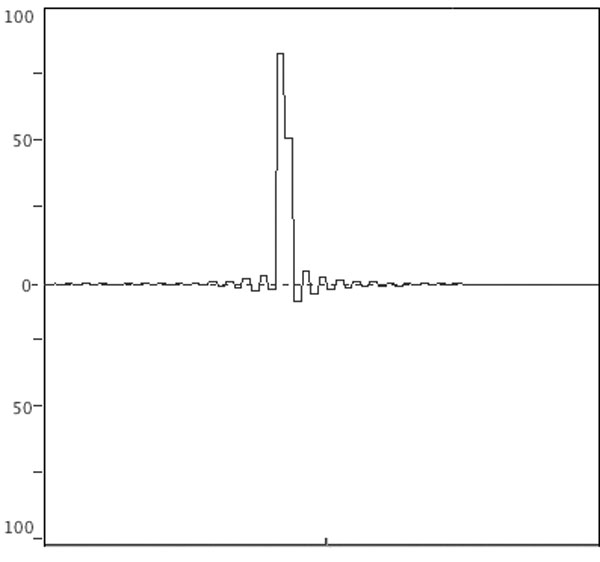

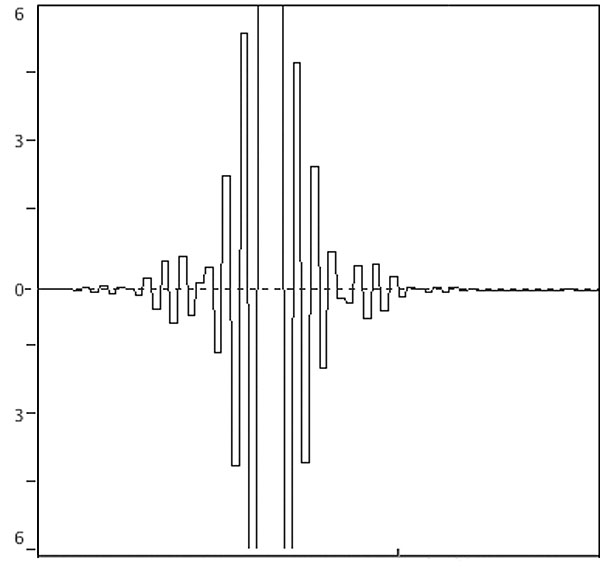

By contrast, the Ayre QA-9's Measure filter (fig.10) is a minimum-phase type, with no pre-ringing (footnote 3). It's also "short," with very little post-ringing visible. But the surprise of the bunch is the Ayre with its Listen filter selected (fig.11)—no pre- or post-ringing is visible, and other than the fourfold reduction in sample rate, the shape of the original impulse has been preserved.

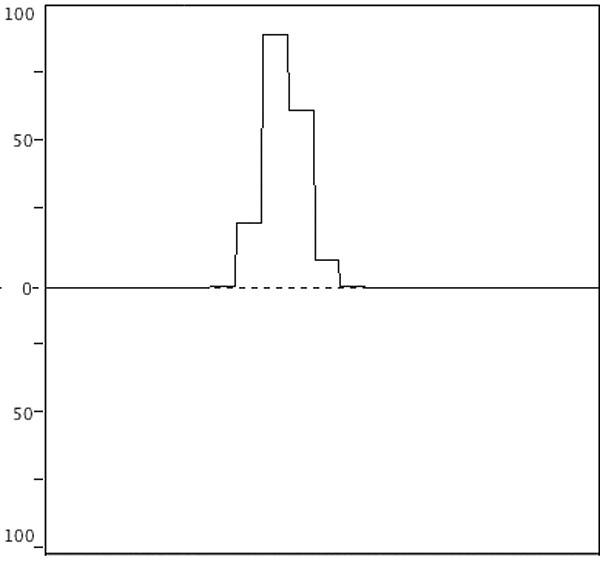
Footnote 2: The QA-9 has since been discontinued, but Ayre had a limited production run in early 2018.
Footnote3: Although Charley Hansen and Bob Stuart disagreed on almost everything audio-related, they shared an antipathy for linear-phase filters.

"It's Time" ........... Imagine Dragons :-) .............

...in fact, usually, very little knowledge is what is exhibited by people who are dilettante A-holes with strong opinions about audio that disagree with you, John.
MQA is rather brilliant. While I understand why it’s not being universally adopted, most people who aren’t engineers who have strong opinions about it don’t even understand basic audio recording and engineering.
Give them the credence they deserve (none).

What footnote 4 appears to indicate, is that all that is required to eliminate the "time smear" introduced by the A/D process is the use of an apodizing filter in the playback DAC. Problem solved without all the additional expense and nonsense of MQA. BTW, one can implement an apodizing filter by oversampling lower sample rate content via the DSP capabilities incorporated into ROON or the use of iZotope oversampling incorporated into Audirvana Plus, all in real time, during playback. All this shows there is no need for, or reason for MQA and its requirement for the audiophile to purchase new hardware with MQA. Just oversample in ROON, or implement an apodizing filter in iZotope using Audirvana Plus and you have solved the "time smear" problem yourself without the need for (purchasing a new DAC with) MQA.

"Satori"? ...............
Zen leading to satori :-) ................

I find little to complain about these days with all the 2496 recordings I can make that sound superb with only average recording equipment and I can complain about nothing. Music reproduction has never been better, but why people would listen to MP3 quality in 2018 and beyond me is still a sad thing to us as music lovers. All I every wanted was a better turntable and cart., better speakers so I could hear more and now for all too many less is just fine. We will never get it.

I would have to agree.
Quite honestly I didn't read the entire article as I am on the road, tired, and have been teaching tech stuff all day..so I didn't want to read more tech stuff.
However, you summation is right on the money. I am very happy with 24/96 and better recordings...and as a road warrior, I can take good sound on the road with me!

...to MP3 because much of it can sound exceedingly good AND I am a music lover. Does that make me some kind of 'heretic'...?

I appreciate that the sound is not as good as my ALAC files, some of the classical 320 kbps files I have received from the Chandos on-line shop are so good that I can easily ignore their prevenance and just enjoy the music. Isn't that what it's all about...?

I appreciate that the sound is not as good as my ALAC files
You can find my technical analysis of lossy formats at www.stereophile.com/features/308mp3cd/index.html.
some of the classical 320 kbps files I have received from the Chandos on-line shop are so good that I can easily ignore their provenance and just enjoy the music.
MP3 does perform at its best at that bit rate, though Apple's AAC codec does better.
John Atkinson
Editor, Stereophile

Does the "law of diminishing returns" play any role? .......... When and where does the law start? ........

May be the problem is "timing errors" rather than resolution per se ........... May be they are inter-related? ..........

If I remember correctly, Bob Stuart (MQA) said that 20 Bit data is sufficient resolution ........... I am not sure about, what sampling frequency he said was sufficient ........

I Agree about Vorbis being a great codec.
I'm running Spotify through Amarra sQ+ which, to my ears, reduces some of the hardness in the higher frequencies.

I rate much of Apple's AAC material very highly. 'Mastered for iTunes' files can sound fabbo. (I love your site; keep the good stuff rolling!)

In one post you mention sounding good, yet in the next you disregard this and mention enjoying the music.
I agree you can enjoy MP3 files of good music, even if they don't sound very good. But no MP3 at 320kbps is going to sound as good as a 24/96 FLAC. You might enjoy it as much, but in hifi terms, there are lots of issues.

...how I have contradicted myself at all. I enjoy listening to music first and foremost. As for the rest, well whatever floats your boat, eh...?

I make MP3 files for specific applications from 192,96,44.1 CD-Res, that are listenable.

in all things audiophile at the down of the 21th century? Well, fine-tuning and convenience aside, absolutely nothing whatsoever. Therefore MQA or something HAS to be fresh and exciting – somehow, anyhow..

Analog vs digital ....... tubes vs solid-state ........ hi-res vs mp3 ......... you choose ........ whatever floats your boat ......... Enjoy the music ........

It seems as though everybody is commenting on everything other than the article at hand.

And that fact reveals a lot.

So how about pristine 44.1 red book with no low-pass filter whatsoever and merely letting our ears cut off ultrasonic aliases? Rumors of wideband amplifier oscillation have never been confirmed for that matter as far as I know. I presume file size/bitrate is not actually an issue in the days of real-time HD video streaming..

...Their Unprocessed State as Performed by Three Groups — Expert Listeners
This paper aims to examine perceived clarity in MQA encoded audio files compared to their unprocessed state (96-kHz 24-bit). Utilizing a methodology initially proposed by the authors in a previous paper, this study aims to investigate any reported differences in clarity for three musical sources of varying genres. A double-blind test is conducted using three groups—expert listeners, musicians, and casual listeners—in a controlled environment using high-quality loudspeakers and headphones. The researchers were interested in comparing the responses of the three target groups and whether playback systems had any significant effect on listeners’ perception.
***Data shows that listeners were not able to significantly discriminate between MQA encoded files and the unprocessed original due to several interaction effects.***
Authors: Generale, Mariane; King, Richard; Martin, Denis
Affiliations: McGill University, Montreal, Quebec, Canada; The Centre for Interdisciplinary Research in Music Media and Technology, Montreal, Quebec, Canada
AES Convention: 144 (May 2018)
http://www.aes.org/e-lib/browse.cfm?elib=19396

I think it's silly for anyone to question whether or not MQA is elegant or not and it IS a brilliant innovation in my mind. The issue, for me, is ultimately traction and the very difficult path to making it matter to anyone other than producers/engineers and the high end community.
Most in my social circle are lifelong music fanatics but have zero interest in something like MQA and there's no use trying to convince them they need new stuff when they are enjoying music so much as is (via streaming, local files or records).

Where's the "elegance" again in MQA?
Which part is the "brilliant innovation"?
How exactly is this lossy compression system "high resolution" even?
Presumably this is the last of Stereophile's series on MQA. Showing a few impulse responses "encapsulates" all there is to the claim of "deblurring", I suppose.
What else to say but time to move on.

...is in the marketing. Throw enough largely incomprehensible goobldygook at people and it HAS to be betterer.

Surprising ......... Nobody mentioned or opined about Bluetooth :-) .........

Nobody mentioned or opined about Bluetooth :-)
You can find my technical examination of Bluetooth codecs in my measurements of Chord's Chordette Gem DAC: www.stereophile.com/content/chord-chordette-gem-da-processor-measurements.
John Atkinson
Editor, Stereophile

Thanks JA .......... I read the article .......... The article is from 2011 (7 years old) ........ I know you (JA) reviewed Chord Mojo .......... Any interest in reviewing the new Mojo/Poly combination? ...... may be other newer Bluetooth capable DACs? ......... One suggestion is Arcam irDACII ...........

The article is from 2011 (7 years old)...
Yes, but the Bluetooth codecs have not changed. Their performance is limited by the low bit rate.
Any interest in reviewing the new Mojo/Poly combination? ...may be other newer Bluetooth capable DACs?
No, because their performance cannot compensate for the limitations of the Bluetooth codecs.
One suggestion is Arcam irDACII ....
I reviewed the irDAC II, in July 2017 - see www.stereophile.com/content/arcam-irdac-ii-da-processor - including measuring its performance via Bluetooth.
John Atkinson
Editor, Stereophile

Bob Stuart's comments leave some questions still to be resolved. Even so just looking at the electrical performance of the digital chain is overlooking other real system constraints.
First, real-world recordings made with real microphones have intrinsic low pass filters with the attendant phase response in front of any recording system. I don't know of any recording microphones with useful response to 60 KHz or anywhere near that. Measuring mikes that can respond that high have way too much noise. Plus the short wavelengths make every physical element near the mike have an impact where the longer wavelengths are much less perturbed. Same physics for recording mikes. Some have 1/2” diaphragms but the most desirable ones have 1” diaphragms and are hard pressed to get to 20 Khz. Still it would be valid to add (convolve) the impulse response of a microphone that has that response to 50 KHz to the impulse response of the digital recording chain and see what you get. Same for a Neumann U47.
I would really like to see some real impulse and tone burst measurements through the complete MQA system.
The concept of conjugate filters and dynamic sync of the encode/decode parts of the chain were first introduced by Keith Johnson and Pflash Pflaumer in the HDCD system. Along with encoding a marker to flag the content as HDCD. It has many of the same features as MQA and was compatible with 16 bit CD. However, it never had real marketing clout.

Any chance you could compare those impulses as reproduced by the speaker of your choosing?

About microphones ............ Some of the readers may not be familiar with Ehrlund triangular diaphragm microphones ......... Search for Ehrlund microphones on Google .......... Ehrlund claims that their triangular diaphragm microphones are superior compared to round diaphragm microphones because they have better impulse response ........... hence, low latency, less time smearing, low IMD ......... Very desirable properties ...........
Since JA is a recording engineer, he may be interested in these microphones ........... JA may be interested in making some recordings with these microphones .............

How can Stereophile see MQA as the solution to poor digital recording/replay sound quality? All these words, but nowhere any reason for pushing another lossy packing app. when the world does not need one. Lossless is available already, has been available for a long time, and data rates + storage are no issues in our time for those who want lossless quality. Lossy is ubiquitous, and has been for a long time - for people who want to pack a lot of music on to their portable devices, at the expense of some compromise of quality. MQA has been around quite a while now and has made close to zero impression anywhere except in Stereophile.
I was pleased to read that you acknowledge that Charley Hansen (i) had his head screwed on and (ii) was a strong critic of MQA. Charley and I exchanged a lot of emails and he was indeed very knowledgable and sensible, and delivered fine products. However it is disrespectful to his memory to say: "Charley Hansen was a vociferous critic of MQA. However, if you compare what I've written in the paragraph above with my earlier description of the goal of MQA's developers, they are, in essence, identical!"
The conclusion is idle talk when it comes to justifying MQA as a finished product rather than talking about the goal of its designers. Donald Trump has "goals" of making America great again and to establish world peace. Great "goals" few would choose to take issue with - but the practicalities end up less easy than the statement of a "goal". MQA is fundamentally a lossy packing app., albeit a clever one which should sound better than mp3 - but nonetheless lossy and consequently fundamentally flawed. Where is Stereophile's listening test evaluating the losses MQA imposes on a lossless original recording? Has anyone independent of MQA Ltd. done any such test? If you subtract the MQA'd version of a 192k/24 source file from the lossless original, what do you hear? The big question remains - who needs MQA lossy packing if the pursuit is audiophile transparency?
When will this dead parrot be laid to rest?

There's some observations about the various digital filters over here: https://www.stereophile.com/content/kalista-dreamplay-one-cd-player
Charley Hansen also pointed out, more than once, that the digital filter is an important part of the system equation, but was well down the list of what affects the perceived sound quality.

I've not been able to hear an A / B demonstration with MQA and non MQA digital recordings so I have no opinion yet. However any format that can compress 24/96 so you can stream it and replace 16/44 bit would be welcome. For me 24/96 is the sweet point, IF you can get it. Too many on line resellers just give you upsampled 16 bit. Until then i'm all about working on my music collection and kinda believe in the Mike Moffat thinking on music collections. Buy gear for the music you have. Regardless, if I listen to vinyl or digital or streamed digital, I find the original recording and mastering quality is the absolute pivotal factor in listening enjoyment.

I agree with you. (I bet that completes your weekend!!)
Between all this transparency talk is a basic fact that's hard to get around. That is, except for a very select group of recordings that were made with two microphones and were not edited - except for cutting into "tracks" - every single recording out there has been deliberately modified.
Somebody, or a whole chain of somebodies, has mucked with the mix, boosted this and cut that, equalized to their taste, and added various forms of compression.
Sometimes it was done to make the track more "catchy" when played on the radio.
Sometimes it was done so that the record could be played on kiddie phonographs (see Fremer's recent comments on Led Zeppelin II).
Sometimes because somebody thought it sounded cool. (Think of all those pre 80's recordings that were "digitized" through somewhat crappy A-D converters by some young recording engineer who was fed a diet of coke - the powder, not the cola drink - to help him stay awake enough to keep the march to CD going as fast as possible)
In any case, it's hardly transparent to the performance. If, in fact, the performance was actually a bunch of musicians who assembled into a room to play together. Very often, that's not the case.
So, in turn, it's hardly unreasonable for a home listener to tailor his or her system to play his/her favorite music the way they want it to sound. Why not? They're doing the listening. It's their home.
We all tend to get worked up over some detail of a single component in the overall system. In truth, barely any attention is paid to the electrical interaction between the various boxes we all use. Heck, most people are unwilling or even unable to improve the acoustics of the room they listen within. (This is an area the headphone guys really have it knocked.)
Slightly OT: This was really driven home to me just before the turn of the century/millenium. My daughter was going to play her guitar in the spring concert at her elementary school.
So, I decided to record it.
We headed off to the local Nobody Beats The Wiz to buy a Sony Walkman Pro. I purchased some wear-on-your-eyeglasses microphones from Sonic Studios. I sat in the back of the room and sat stock still while recording this.
Later, when playing it back on the home system, I was completely amazed at how close to the real thing it sounded. I never, ever, expected that. We would have been thrilled just to have the Instamatic equivalent of the concert sound. But, it was much, much better. Far more realistic in terms of what the original sounded like than virtually all our commercial recordings. At least what we imagine a bunch of musicians playing in a room would sound like. (My wife is actually a degreed musician who had studied with some of the people we have recordings of, so I have to take her word for it. I am just a guy off the street.)
This was all done by a guy (off the street...) who didn't know what he was doing with equipment that hardly qualified as professional quality. OK, I guess the Pro in Walkman Pro suggested professional, but I don't think many recording studios based their work around a little cassette recorder in their control room.
What conclusion do you draw?


Are people still seriously talking about MQA?
When it was first announced, the USP was enabling HD streaming at standard definition bit rates. That is now firmly ancient history, I've been streaming Qobuz up to 24/192 for several years and all you lucky audiophiles in the USA will be able to do so when they launch Stateside in the next month or so.
Ever since it's been looking for a reason to exist and has yet to find one. At the most basic level, when the CD was brought to market in the early 1980s anyone who was semi-conscious with some residual hearing capacity could tell the difference between vinyl and CD. It did not matter whether the listener preferred one or the other and, bizarrely, that argument still whimpers on. All that matters is that there was a difference to justify the new format, besides a quantum change in practicality and durability. Most listeners of classical music left emotion out of the debate on entering the digital world and never looked back.
The fact that several blind listening tests have been carried out and that it has not been shown with statistical validity that MQA and non-MQA can be told apart should be enough to consign it to the dustbin of audio history. Reference above to "expert listeners" is enough to raise my blood pressure to a level at which the only release is to grab the largest kitchen knife available and murder the nearest sofa. Any mass-market product must have perceived benefit to the average punter (the man on the Clapham omnibus), and if your market is limited to expert listeners then the audio dustbin should be close at hand.
Which gets me to the article. Finnegans Wake was an easier read, made more sense and was funnier. I hope the article made sense some people, it made none to me, I thought someone was having fun publishing an article in Ethiopian Coptic. If MQA requires understanding at this level to convince people to adopt it, then I suggest Bob Stewart could spend his time better introducing ice hockey into Namibia. He'll make as much money as he'll make out of MQA (none), but will realise the error of his ways a lot quicker (due to the lack of ice).
On the subject of Namibia, I was there recently with my Mojo DAC, Mr Speakers headphones and about 50gb of offline Qobuz HD downloads on my phone. I was at one lodge with no services at all - water was filtered from a dry riverbed, solar electricity, occasional wifi as they'd installed a few repeaters, the nearest road was 2 hours away and the nearest mobile signal a further 3 or 4 hours. As I sat on a sand dune listening to Bach, all was peace and I couldn't have been happier. The sound was sublime. Try convincing me I need another format.
FWIW (as they say these days), my unit from Devialet turns anything that hits it, including analogue, to 24/192 and does it's jiggery-pokery on that, including BBC Radio 3 that is the bastion of broadcast technology and civilisation as we know it, and broadcasts at mp3 or lower.

Thanks, JA, and kudos for your fine article on A-to-D conversion in the September 2018 issue!
After all the widespread handwringing about evil commercial interests foisting an MQA monopoly on innocent music lovers, it's a relief and boon to see your careful, objective, fully substantiated demonstration of how:
- Typical digital audio recorders (from which come the hi-res PCM files many regard as the best digital audio can do) introduce time smear and ringing during A/D conversion which typical playback systems can't and don't fix, and to which those playback systems' D/A converters typically add;
- A/D converters following a particular unusual design approach don't introduce significant time smear or ringing during recording; and
- Recordings made that way can then show substantially perfect impulse responses if D/A conversion in playback is also done following a particular unusual design approach.
Your final paragraph then calmly pointed out that if MQA can indeed reach upstream into existing PCM files and remove the time smear and ringing caused by typical A/D converters during recording, then MQA encoding could permit those existing PCM files to be able to be played back with substantially perfect impulse response.
You neither endorsed nor dismissed MQA. You did show that substantially perfect impulse response can be attained in a digital audio system if both A/D and D/A operations follow specific but not typical approaches. You left room for MQA to demonstrate it can not only provide the necessary D/A conversion but also remove time smear in existing recordings not made with suitable A/D converters (i.e., nearly all, though not the ones you've made with the Ayre A/D, thank you!).
Those of us who especially value the time-domain performance of audio systems welcome the prospect of routinely hearing music reproduced with all attacks, rim shots, and other interesting transients delivered without smear (at least until the speakers make their contribution).
Please persevere in measuring and presenting impulse responses for digital gear, step responses for speakers, and fast square wave responses for analog electronics. We can hope manufacturers begin to recognize the value of improving all those.
Thanks again!

... has been solved. You design a DAC with a much higher tap count such as Chord and iFi have done. The problem is, we're still stuck in the past with DACs that haven't changed design in over a decade, with lousy built-in filters, leading MQA to come along and try and "solve" a problem that should have been solved by manufacturers. Unfortunately now the "solution" is to run all the music through some kind of compression so they can say "Listen! It sounds better!" which wouldn't have worked if it were just compressed high-res music. To me, the whole b-spline etc. discussion is just to avoid the fact that they can no longer say they are reproducing the studio master, as that has been shown, very comprehensively, not to be true.
Regardless, the discussion in this article on digital ranges, as I understand things, from out-of-date at the very least, to wrong. Infinite slope impulse responses, don't exist in music, as they contain out-of-bandwidth frequencies, so using the ringing caused by a DAC's response to out-of-bandwidth signals to explain what is going on is nonsense. Show me an in-bandwith signal that has ringing using a conventional filter! I'll bet that you can't!.

Show me an in-bandwith signal that has ringing using a conventional filter! I'll bet that you can't!.
Fig.15 in this article shows just that. With the DAC decoding data restricted to "legal" frequencies but with sinc-function content at Nyquist (fig.12), the DAC's own filter rings. (Note that this reconstruction filter attenuates content at Nyquist by >20dB, so the ringing in this graph is not that in the original data, but is the filter's own ringing.)
John Atkinson
Editor, Stereophile

That signal is exactly at Nyquist though, and irrelevant to actual music. It doesn't change the fact that musical content doesn't show ringing.

That signal is exactly at Nyquist though, and irrelevant to actual music. It doesn't change the fact that musical content doesn't show ringing.
The measurements in this article indicate that every musical transient in the master will be accompanied by sinc-fuction ringing at Nyquist. This will be either from the original A/D converter (if the recording was made at 44.1kHz), or from the sample-rate converter used to create the CD master. That ringing will excite the playback DAC's reconstruction filter, which will impose its own ringing on musical transients.
Yes, a surprising result.
John Atkinson
Editor, Stereophile